Mike Farrell contributed the skipper photo. All other photos by the Old Naturalist.
Download the Midwestern Butterflies Activity. Answer the questions using the text below. Click here for the PDF.

Monarchs resting in the morning light
The monarch butterfly is a large (4″) orange butterfly. It is very common and the Minnesota State butterfly. Male monarchs can be told by the thin veins on the wings and the scent glands on the lower wings. Monarchs are the only butterfly in Minnesota to migrate.
Monarchs from the Upper Midwest and Eastern United States migrate to the Sierra Madre Mountains in Central Mexico, a distance of over 1700 miles from Minnesota. Monarchs begin their migration in late summer. At that time thousands of butterflies may be seen overhead or resting in trees. Migrating monarchs may live for 6 months, while those who lay their eggs during the summer may live only eight weeks.
In the summer, monarchs feed on many types of prairie flowers including milkweed, stiff goldenrod, and blazing star. The monarch caterpillar feeds only on plants from in the milkweed family.
The viceroy is often confused with the monarch. Viceroys can be distinguished from monarchs because it is smaller (3″) and has an extra black line across its lower wing. It was originally believed that the viceroy “mimics” or looks like a monarch because the monarch was more poisonous to predators and gave some protection to the viceroy. However, recent studies have shown that both the monarch and the viceroy have an equal amount of toxicity to predators.
Viceroy larvae feed on willow trees, and hibernate through the winter. Viceroys usually are nectar feeders, but they also will eat the “honeydew” of aphids (droppings), decaying fungi, or even dung.
The cabbage butterfly is a common white butterfly seen in the backyard. They are considered pests by gardeners because the larvae eat cabbage, broccoli, and other members of the cabbage family.
The sex of a cabbage butterfly can be easily told: the female has two dark spots mid-wing, while the male only has one spot. A male will chase a female when it is interested in mating with a female. If the female is not interested in the male, the two will rise in spiral flight, circling each other.
Cabbage butterflies are easy to rear and great to bring into the classroom, where students can see the butterfly go through its entire life cycle in only three weeks.
The sulphur butterfly is usually yellow, but females can be yellow or white.
Sulphurs have a short life cycle, which allows them to have several broods in the summer. As a result, sulphur populations tend to increase throughout the summer, and peak in September. Thousands of these yellow butterflies may be seen in clover and alfalfa fields. Some years, sulphurs may be the most common butterfly found in the Eastern United States. Adult butterflies feed on a wide variety of flowers.
Eggs are laid on the leaves of clover and alfalfa plants. During courtship, a male will flutter above a female. If she is receptive, she rests on a leaf. If she is not receptive and rejects him, she will fly upward in a circular motion, with the male chasing after her. So, if you see the spiral flight of two sulphur butterflies, it is a female rejecting a courting male.
Swallowtail butterflies have two tails projecting from the rear of their body. The purpose of these tails is to fool bird predators into grabbing the tails rather than the main part of its body, allowing them to survive another day.
The caterpillars are camouflaged and have been described as looking “like bird droppings” on a leaf. However, if the larva is disturbed, it extends two red horns from its underside. This behavior may frighten a bird predator from eating it. The caterpillars over-winter as a pupae, often near the ground. The adults emerge from the chrysalis in the spring of the following year.
The tiger swallowtail is one of the largest butterflies in the backyard. Although they are normally yellow in color, females can be mostly black. Tiger swallowtails are active and visible feeding on a variety of summer flowers. The caterpillars feed on black cherry and willow leaves.
Tiger swallowtails may also be seen gathering around a damp place or puddle. Almost all butterflies at “puddling sites” are males. They are attracted to the sodium, a component in salt. Males need extra salt for mating.
Black Swallowtails are beautiful butterflies. They feed on a number of prairie plants.
To protect itself from bird predators, the black swallowtail is a “mimic” looking like the poisonous spicebush swallowtail. The black swallowtail, itself, is not poisonous.
Sometimes there may be several black swallowtails flying around a hilltop.
They tend to fly up hills, increasing their numbers, so that males can more easily find females. To court a female, the male will repeatedly fly up in front of her. If she is receptive they will mate.
The females lay their eggs on plants in the parsley family (including carrot and queen Anne’s lace). The butterfly over-winters in its pupa stage.
The great spangled fritillary is an orange and brown butterfly that can be confused with a monarch. They prefer moist, open fields and gardens, feeding on black-eyed susan flowers, purple coneflower, milkweed and other prairie flowers.
The eggs are laid on violets in September and the adults die. Caterpillars hatch in the fall and feed on the violets. The caterpillars hibernate during the winter and in the early spring the caterpillars feed on fresh violet leaves. The caterpillars develop large spines, which protects them from bird predators. The pupa is dark brown and looks like a dried leaf. The adults emerge from a chrysalis in late June live as adults during the summer.
Brushfooted butterflies include anglewings, red admirals, mourning cloak and painted lady butterflies. The name “brushfoot” refers to the male’s front pair of legs. They are “brushy” and not used for walking. This group of butterflies walks on only four legs.
Anglewings are named for their jagged wing edges. They are found in open areas of forests. Their closed wings looked like the bark of a tree, and when they are disturbed, they will perch on a trunk.
Most butterflies do not survive Minnesota winters as adults. But the anglewing, red admiral, and mourning cloak butterflies hibernate as adults, and remain all winter under the loose bark of trees and in hollow logs. In early spring, they use their dark wings as solar collectors and raise their body temperature well above the air temperature. This allows them to fly on chilly spring days. In the spring, they rely on spring flowers, like dandelions, and also feed on maple sap.
The red admiral can be told by the orange-red bands that cross its dark wings. Red admirals are found at the edge of moist woods and in gardens. Their population size changes from year to year. This species is known for large numbers one year and then very few the next year. In 2001, there was a population explosion of red admirals, with hundreds of butterflies in backyards and forest margins. In 2008-09, I didn’t see any red admirals through the entire summer.
Not many people would want stinging nettle growing in their gardens at home, but if you want to attract anglewing and red admiral females, they lay their eggs on nettles in May. The larvae feed on nettles and then form a pupa. The adults emerge in late June. There are two generations of butterflies in the summer with the second one emerging in September and hibernating through the winter.
Mourning Cloak butterflies are a beautiful sight to see in the early spring after a long winter. They can live up to ten months, which may be a record for butterflies. Mourning cloaks are found in open areas of forests. The eggs are laid on the leaves of willow, cottonwood, and elm trees in early June. The adults emerge in late June and live till September. A second generation lives from September to June of the following year.
Painted Lady butterflies may be the world’s most widely distributed butterfly. They are found throughout North America, Central America, Asia, Africa, and Europe.
This species is known for its extremely large numbers one year, and then very few the next year. In Oct. 2007 there were hundreds of painted ladies in gardens across the Twin Cities. During the summer of 2008, I saw only one or two of them.
Painted lady butterflies can tolerate the cold and have been seen flying about on warm November days. It is
believed that some may over-winter as adults.
Painted lady larvae feed on thistles, hollyhocks. While adults feed in open areas, gardens and prairies.
The red spotted purple does not usually feed on the nectar of flowers, but eats rotting fruit and plant material, dead animals, and the sap of trees. The red spotted purple has two generations of adults in the summer. In the fall, a caterpillar will roll itself in a leaf that is held together with silk and form a winter hibernaculum where it will remain for the winter.
The eggs are laid on willow and black cherry trees. When the caterpillar hatches it will feed on the leaves of the tree. The caterpillar is camouflaged and looks like bird droppings.
Buckeye butterflies have four large eyespots on their wings to distract possible predators, like birds. The males will perch on dirt trails or roads while seeking a mate. If a female flies overhead, the male follows her until she lands. The male will hover above her and then then settle behind the female, beating his wings. This may occur several times before they mate.
I have been a student of butterflies for 50 years and usually think of skippers as “little brown guys”. They get their name from their “darting” flight behavior. Skippers have been described as butterfly-moths because they have characteristics of both moths and butterflies. They have a moth-like body and large compound eyes. When feeding they hold their wings closed like a butterfly, but at other times they rest with their wings spread out at different angles (pictured to the right).
The Cecropia moth is 5-6 inches in size and the largest moth in North America. They are active at night and attracted to outside lights. The Cecropia hatches from its winter cocoon when the weather starts to warm up in late spring. The most common time to see them is from late May to Mid June. The females emit a scent, called a pheromone, that attracts males up to a mile away. A naturalist once told me that he had a recently hatched female Cecropia in a cage . One night he went outside to check on the moth and there were two male Cecropias perched on the cage, apparently attracted to the female’s pheromone.
Sphinx moth is a day-flying moth that feeds on the nectar of flowers. Sphinx moths have a long proboscis to gather the flower nectar. They are also called hummingbird moths because their feeding behavior around flowers resembles that of a hummingbird. Sphinx moths are most visible from late spring to late summer.
The Ctenucha moth is a day-flying moth that feeds on the nectar of flowering plants. The best time to see it is from mid summer to fall.

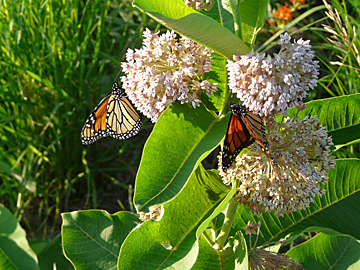
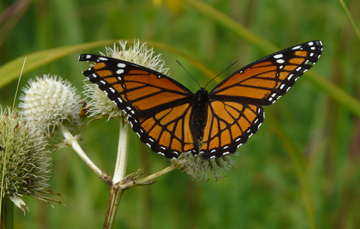
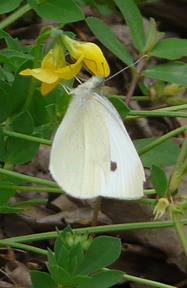
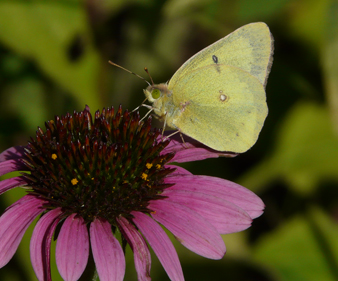

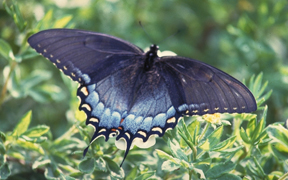

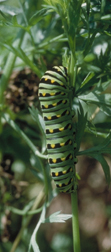
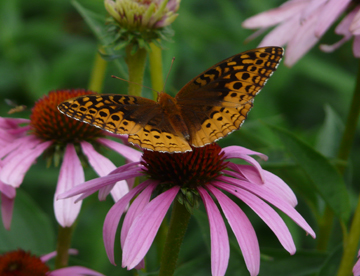

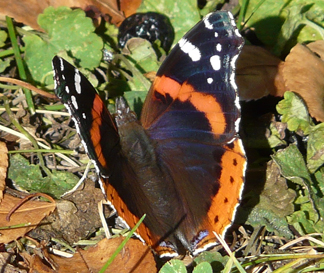
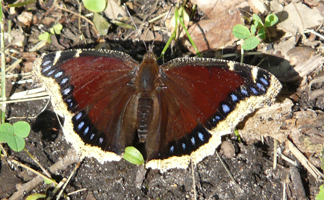
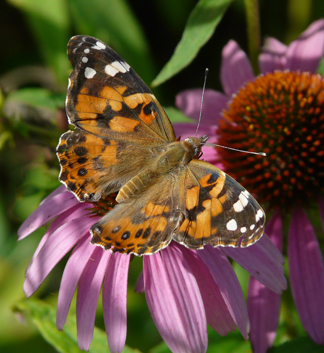

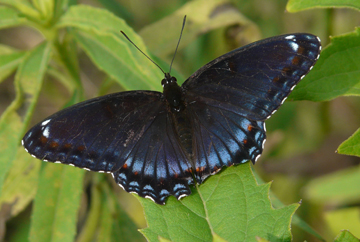
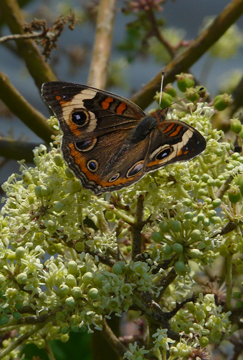
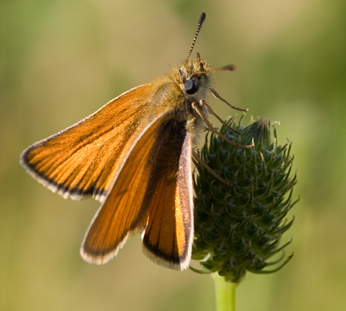
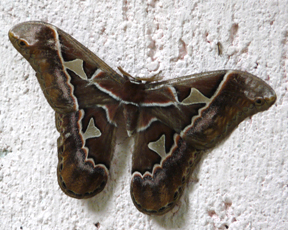
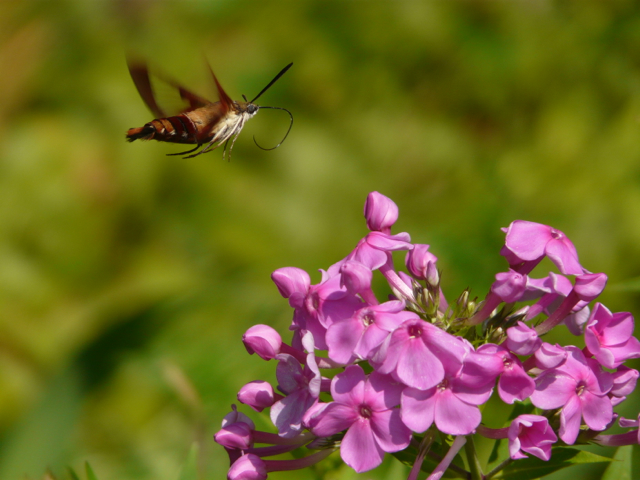
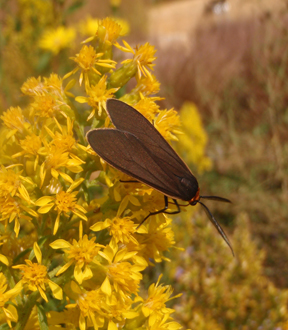



Is this a picture of a sulfur butterfly? It’s in the middle of Omaha, Nebraska, in my backyard apiary.
It sure looks like a sulphur! Here is a picture of one from an hour north in Monona County, Iowa.
Does any one know what butterfly or moth this is
I just recently found out these are Hackberry Emperor butterflies! They were always landing on my hands or arms and then I found out they like the salt on human skin, interesting!
The last couple weeks, I’ve noticed lots of bees and Painted Ladies feeding together on some of our flowers up here by Lake of the Woods. The PLs seem as skittish as our magpies, flying off at a little nearby (human) movement while mostly ignoring the bees.
Thank you for the picture of the Painted Ladies. Have a large number of them on my commercial property feeding on the wild sun flowers
Unfortunately we can no longer say that the monarch butterfly is ‘very common’. Numbers have declined by 80%, but there are lots of grassroots efforts to reverse the decline
2017 has been a great year for butterflies and bees. Im seeing more than ever for some reason. Follow Minnesota Naturalists on facebook and find out what is going on in other areas.
Thank you for posting the image and information about the Red Spotted Purple.
I just saw one today and could not identify it.
Was thinking in the Tiger Swallowtail realm, but it was indeed different.
I was able to pick it up on my finger, nice.
Location: Beach on Lake St Croix, St Croix River, Near Hudson, WI.
Pingback: Butterfly Gardens
Pingback: Bye bye, butterfly | creatures, trees & water
I just shot a butterfly its called ,Tree Bark Butterfly with orang wings . I wish i could send you a picture of it . I asked my daughter to help me find how he came in my City , i live in Port Colborne Ontario Canada , or if you go to Flickr witch is Yahoo you will see it . Hope you do and pass on some info about it Thank you John .
The giant silk moth picture shown on your website that is called a “Cecropia Moth” is actually a “Window-winged Saturnian” or the species “Rothschildia orizaba”. Thought you would want to know.